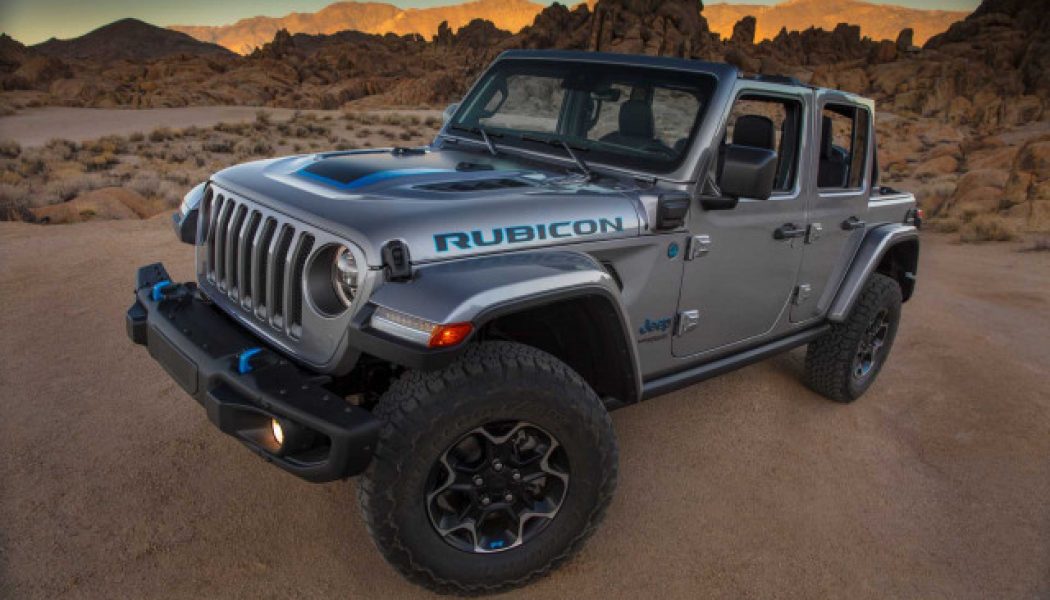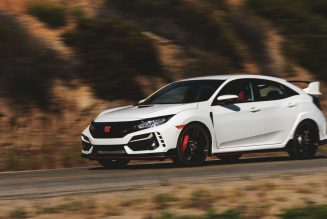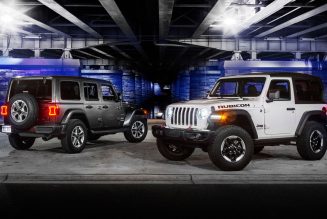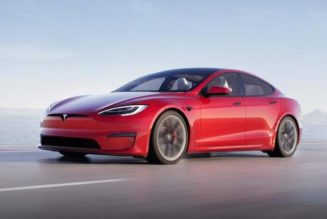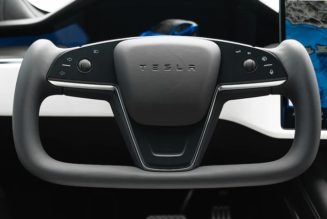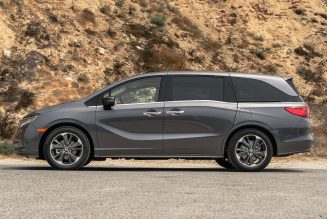A Jeep Wrangler with a plug and an electric motor is finally here. The Wrangler 4xe—pronounced “four-by-e,” like “four-by-four”—mixes a battery, electric motor, and turbocharged gas I-4 engine to deliver up to 49 MPGe (miles per gallon equivalent) and 21 miles of electric-only driving range. These plug-in hybrid specs likely are as foreign to the off-roaders and sun-lovers who typically shop Wranglers as the usual Wrangler figures covering ground clearance, breakover angles, and water fording depth are to everyone else.
In theory, plug-in hybrids combine the most useful elements of electric and gas vehicles, offering silent, engine-off motoring for shorter commutes and cross-country travel fueled by readily available gasoline. Their real-world utility depends on customer use. Don’t plug in often? Congratulations, you overspent on what amounts to a regular hybrid with extra battery weight that offsets most if not all of its efficiency gains. The 4xe’s 20 mpg combined in hybrid mode, for example, is on the low end for the rather thirsty Wrangler lineup.
The 4xe therefore is a niche Wrangler in search of the right owner, ideally a Jeep fan with a nagging jealousy of the neighbor’s Tesla but who isn’t ready to go fully electric. Access to a charger and a commitment to plug in at night, juicing the heavy battery for local use the next day, are musts. (Charging takes about 12 hours on a 110-volt wall outlet, or just two with 240 volts.) Most people drive fewer than 40 miles per day, half of which the 4xe could cover without using a drop of fuel. Unlike in a Tesla or other full EV, “Range anxiety” won’t ever cross the 4xe buyer’s mind. The gas engine is there as backup.
Wrangler, De-Simplified
The 4xe buyer also must be comfortable driving the most complex Wrangler in history. Only a few years ago, the Wrangler came only with a gas-fed V-6. Today, there also are mild-hybrid eTorque V-6, turbocharged I-4, turbodiesel V-6, and 6.4-liter Hemi V-8 choices.
Jeep reenlisted the Wrangler’s recently discontinued mild-hybrid eTorque-ified turbo I-4 (270 hp, 295 lb-ft) and its beefed-up electric starter/generator (44 hp, 39 lb-ft) for the 4xe, adding a 134-hp, 181-lb-ft electric motor and a pair of clutches where the eight-speed automatic transmission’s torque converter would be. Engineers shoehorned a 17-kWh lithium-ion battery under the rear seat, tucked an array of electrical equipment between the left frame rail and the rear driveshaft, and installed a charge port on the left front fender.
The result is a weird Wrangler indeed: Total combined output is 375 hp, making the 4xe the second-most-powerful Wrangler next to the 470-hp, V-8-powered Wrangler 392. Peak torque is a massive, V-8-tying 470 lb-ft. Yet the 4xe weighs between 500 and 700 pounds more than an equivalent four-cylinder model, making it the heaviest in the range.
You wouldn’t know it pressing the accelerator to the floor. This Jeep whooshes forward with urgency, squealing the rear tires if the transfer case is left in two-wheel drive. The quickest acceleration requires the full-time four-wheel drive be engaged, and Jeep claims the sprint to 60 mph takes six seconds flat.
We giddily and repeatedly shot the Wrangler 4xe to highway speeds and beyond, and the strangest part wasn’t how easily it did so but how much more stable it felt at higher velocities than a typical Wrangler. They are usually handfuls at high speeds, with the merest sneeze of crosswind or irregular pavement sending the tall, dual-solid-axle SUV wayward. The weighty battery seems to better anchor the 4xe to the pavement. More than a feeling, the electric hardware objectively lowers the Wrangler’s center of gravity and shifts it rearward, delivering near-perfect 50-50 weight distribution and among the best handling you’ll find in any Wrangler.
In Electric mode, the Wrangler 4xe feels peppy pulling away from a stop and sluggish beyond. That’s because in this mode, Jeep tunes the throttle-by-wire to offer a long-travel, low-response pedal to deliver maximum electric drive torque at a wide range of pedal inputs, so drivers can take fuller advantage of the motor without accidentally firing the engine. And the Jeep delivers on its promised EV-only range. Starting with less than a full charge, we went about 20 miles in mixed driving.
How Does This Thing Work?
Here’s where the “but” creeps in. The 4xe is complicated, and it benefits from an engaged user. Drivers are given control over how the gas engine and electrified goodies work together via a trio of buttons to the left of the steering wheel labeled “Hybrid, Electric, and E-Save.” Here is a quick rundown of how those work:
Hybrid: The computer figures out how to blend power sources for maximum efficiency.
Electric: Only the primary electric motor moves the 4xe, and the engine stays off unless the driver presses the accelerator to the floor.
E-Save: Operates the 4xe as a hybrid while maintaining the battery’s state of charge. Drivers can further direct the 4xe to charge the battery in E-Save using the gas engine, sacrificing some fuel efficiency in order to juice the battery for more fully electric driving later and without needing to plug in.
No matter what mode you’re in, the battery never goes totally flat—the computers retain a reserve even after the electric-only driving range is exhausted. This saves the battery, plus the aforementioned maximum performance requires both the engine and electric motor working together.
Trail-Rated Electric 4×4
Jeep made sure the 4xe not only delivered the capability Wrangler buyers expect—but that electrification enhanced that capability. As with other Wranglers, the 4xe can ford up to 30 inches of water; we drove it lengthwise down a deep creek, and didn’t need to put the Jeep in a gigantic bag of rice like a wet smartphone afterward.
The electric motor’s instant torque is a boon when rock crawling. We scrambled over some rural Texas rock formations in a 4xe Rubicon model using electricity only, and, here, the motor delivered precise throttle response from small pedal inputs. In the four-wheel drive’s low-range setting (a 4:1 crawl ratio in Rubicons), drivers can adjust their speed using only the transmission’s manual shift mode, each successive gear upping the crawling speed. And while EV motor is quiet—almost jarringly so—in 4Lo it spins up enough to make a mild whirring noise that rises in sync with pedal inputs, offering an engine-adjacent ear-foot feedback loop.
An excellent use case for the E-Save mode? Holding onto a full charge until you reach an off-road trail, where you can then hump rocks in Electric mode (Jeep says the battery delivers several hours of off-roading) all afternoon, leaving plenty of gas in the tank for the trip home or making it to potentially faraway gas stations. Or not—Jeep is installing solar-powered public chargers at trailheads across the U.S., so you can juice up before or after a dirt session.
Not All Rainbows and Sunshine
Wrangler 4xe downsides are few but hard to ignore. There is a lot going on in the powertrain, particularly at low speeds. For example, the engine is clutched to the transmission and primary electric drive motor; this clutch opens for the engine to shut down (or power only the starter/generator to charge the battery) independent of the EV motor handling acceleration duty.
A second clutch separates the electric motor from the driveline and opens when the vehicle is stopped so that the engine (if clutched in) doesn’t stall. Without a torque converter, the transmission uses this second clutch enable slight forward “creep” regardless of whether the engine is on. Getting the engagement right was key, Jeep’s engineers say, to giving drivers confidence off-road. They’re right—we felt the connection was better off-road. In 4Lo, the clutch felt constantly engaged. On-road, it was less successful, and we noticed the clutch decoupling and coupling at low speed by a shuddering sensation.
Braking, like the throttle, is entirely “by wire.” Pedal applications are digitally divvied between the friction brakes and the electric motor. Pressing the “Max Regen” button on the dashboard enables nearly one-pedal driving, using the motor’s resistance to generate up to 0.3-g of braking force, enough to rapidly slow the Wrangler by lifting off the accelerator, though coming to a stop still requires pressing the brake pedal. Jeep cuts out the motor from the braking effort at low speed, noting how little energy is recaptured there and that low speeds aren’t good for the motor. This hand-off goes unnoticed during braking inputs that start above about 5 mph and bring the Jeep to a complete stop, and pedal feel is reasonably consistent. At parking speeds, the pedal only manipulates the friction brakes and the resistance and engagement is softer. The variable action recalls hybrids of old—and are a reminder that this is only the second plug-in Chrysler has introduced after the Pacifica Hybrid minivan.
Some of these issues are endemic to modern PHEVs, so the Jeep isn’t exactly behind the curve. And it comes out ahead on cost. While the 4xe starts at a steep $49,490 for a Sahara (and $53,190 for a Rubicon like the one we drove), Wranglers equipped with stuff most people want run over $40,000. The 4xe includes that stuff and currently qualifies for the $7,500 federal EV tax credit, helping to address much of the price premium. Quick, novel, and beneficial to the Wrangler’s core off-road competencies, the 4xe is intriguing enough that Jeep-curious shoppers needn’t set up a spreadsheet to determine whether it pencils. They need only ask themselves how committed they are to plugging in.
| 2021 Jeep Wrangler 4xe Plug-In Hybrid | |
| BASE PRICE | $49,490 |
| LAYOUT | Front engine, front permanent magnet electric motor, 4WD, 5-pass, 4-door SUV |
| ENGINE | 2.0L/270-hp/165-lb-ft turbo DOHC 16-valve I-4 (gas), 44-hp/39-lb-ft (starter/generator), 134-hp/181-lb-ft electric motor; 375 hp/470 lb-ft total output |
| TRANSMISSION | 8-speed automatic |
| CURB WEIGHT | 5,000-5,222 lb (mfr) |
| WHEELBASE | 118.4 in |
| L x W x H | 188.4 x 73.8 x 73.5 in |
| 0-60 MPH | 6.0 sec (mfr est) |
| EPA COMB FUEL ECON | 49 MPGe (electric); 20 mpg (gas+electric) |
| ON SALE | First Quarter 2021 |
